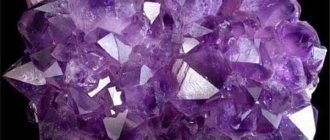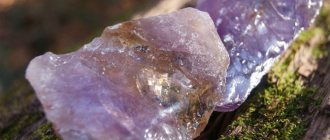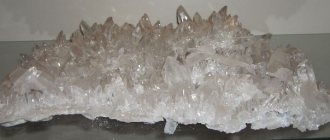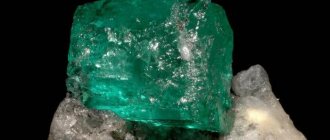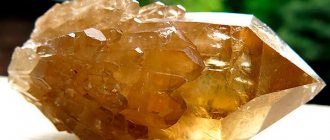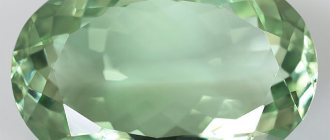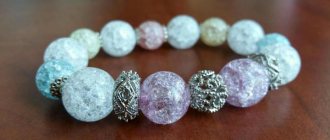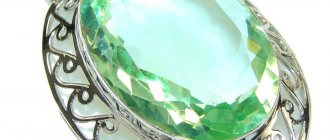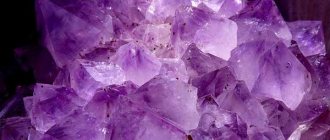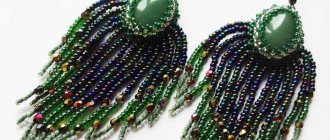By its nature, quartz is a mineral mineral in the form of silicon oxide (SiO2), which is considered the most common in the earth's crust. Minerals of the quartz group can most often be found in silica, a soil structure with pronounced polymorphism.
In modern geology, quartz is known as the rock-forming mineral of most metamorphic and igneous rocks. The total mass fraction of the mineral is at least 60% of the total content of all minerals. There are many varieties of quartz, differing in appearance from each other in color, genesis and shape. It also has a number of different modifications.
Mineral structure
The main polymorphic modifications of crystalline quartz include:
- trigonal beta quartz, which is resistant to temperatures up to 573°C;
- silicon dioxide in the form of hexagonal alpha quartz, resistant to pressure of 100 kN/m2 at a temperature of 870-573 oC.
Beta quartz is the most common natural form, alpha quartz is mainly presented in the form of paramorphoses of the first through the second. Crystallization of the first form has a framework crystal structure with a base of oxygen-silicon tetrahedra with a helical arrangement (left/right helical path) relative to the main crystalline formation.
Depending on this feature, it is customary to distinguish left and right morphological and structural forms of quartz crystals, which differ in appearance by the symmetry of the arrangement of faces. Alpha quartz lacks a center and plane of symmetry, due to which the mineral is capable of exhibiting pyroelectric and piezoelectric properties.
Other known modifications of polymorphic silica include:
- tridymite;
- cristobalite;
- moganite;
- stishovit;
- coesite;
- Seyfertit.
The beta-quartz crystalline tetrahedron has two pairs of oxygen ions located with a vertical displacement relative to the silicon ion (one pair from below, the other from above). Tetrahedral formations are located in three layers at different heights. Together these groups form a spiral - all spiral elements have a twist in one direction.
If we consider the low-temperature alpha modification, then structurally it is not very different from the beta analogue. During the process of polymorphic transformation of a high-temperature form into a low-temperature one, oxygen-silicon tetrahedra are displaced relative to the center, which leads to compaction of the crystal lattice with a violation of its symmetry.
Thus, triple axes are formed from six-axes, but the bonds between groups of tetrahedrons remain unchanged. There are also no changes in terms of helical inversion.
Other Interesting Facts About Quartz
There is an opinion that quartz has healing and magical properties. So, there is even a method of treating a person with the help of gems - lithotherapy. Some believe that quartz prevents colds as well as other respiratory diseases. In folk medicine they use water infused with quartz, the so-called. “quartz water” for rejuvenation, as lotions and compresses for burns and skin diseases.
According to beliefs, quartz, regardless of its variety, attracts love, luck, success and material wealth, and, in addition, each mineral of the quartz group also has a whole range of magical properties unique to it.
Astrologers believe that some zodiac signs can use quartz products as amulets and amulets, while others cannot. Thus, quartz products are suitable for Scorpios, Libra, Aquarius, Taurus, Aries, Leo and Sagittarius and are not suitable for Virgo and Gemini.
Anna Arkhipova
Photos by Pavel Raspopov
UraloVed.ru
Morphological characteristics
A typical crystalline form in terms of morphology for quartz is a hexagonal prism, having at one or both ends, depending on the type, a triangular or hexagonal head in the shape of a pyramid. Often the crystal structure becomes thinner towards the head. The faces of the prism have transverse strokes. Often the crystals have the shape of an elongated prism, in which a pair of rhomboids and a hexagonal prism have developed faces that form the crystal head.
Dipyramidal crystals of pseudohexagonal shape are much less common. Often quartz crystals of regular shape have a complex double structure with the formation of twin sections in accordance with the so-called Dauphine and Brazilian laws
This occurs not only during crystal growth, but also as a result of internal transformations at the stage of beta-alpha polymorphic transitions when the temperature environment changes. Such processes are accompanied by compression and some mechanical deformations.
Metamorphic and igneous quartz ores are formed in the form of grains of irregular, isometric shapes, which usually grow together with grain-like samples of other mineral rocks. Often quartz crystals encrust tonsils and voids inside effusive materials.
If we consider sedimentary rocks, quartz is found in their composition in the form of geodes (secretions/discharges), veinlets, concretions, as well as brushes of short-prismatic small crystals inside limestone voids. You can often find quartz of sedimentary origin in the form of fragments of sand and pebbles.
Zodiac compatibility
The most benefit will come from quartz, which matches the horoscope:
| Zodiac sign | Quartz color, action |
| Aries | Purple and snow stone will help improve relationships with others and finish important things. |
| Taurus | The green and smoky mineral will help solve complex problems, fill you with positivity, give you confidence, and warn of a threat. |
| Twins | A gem of yellow and red shades will help improve your personal life, give you success, and protect you from negative influences. |
| Cancer | Purple and gray will bring peace, help solve complex problems, and improve matters on the love front. |
| a lion | The pink mineral will bring success in all endeavors. |
| Virgo | Snow, pink, and purple quartz will help you find a way out of difficult situations, clear your thoughts, and protect you from negativity. |
| Scales | A yellow and smoky gem will fill life with harmony, help you find true love, and improve your health. |
| Scorpion | Hairy, smoky stone will bring good luck and give peace. |
| Sagittarius | Rose quartz will protect you from rash actions and bring success. |
| Capricorn | A smoky and snowy crystal will fill you with strength, make you more sociable, and protect you from negative energy. |
| Aquarius | The yellow, golden mineral will charge you with energy and give you happiness. |
| Fish | Blue, pink, green stone will bring success. |
If you choose the wrong quartz according to your zodiac sign, it can harm a person.
Which shades of quartz are more attractive to you?
ColdWarm
Talismans and amulets
As mentioned, the effect of quartz depends on the color. For example, rock crystal is able to program certain steps, a pink mineral - gives harmony with the world and oneself, green - will relieve fears, relax, bring success, smoky - will relieve resentment, red - will give or return love. A white stone will fill a person’s soul with goodness, positivity, protect against negativity, and give good luck in all endeavors.
The most powerful are talismans with quartz in a silver frame. Such amulets give success at work, in personal life, and help improve health.
Physical characteristics and properties
The properties of this mineral and their manifestations are generally diverse, which determines its variability and, in a way, uniqueness.
Mechanical characteristics
According to the Mohs scale of relative hardness, quartz has a reference value of 7. Its density is 2.65 units. The mineral belongs to the class of glass-forming oxides.
It often becomes the main component of one-component quartz glass (formed on the basis of pure silicon oxide by melting vein quartz, quartz sand and rock crystal).
As already mentioned, silica has polymorphic properties with a more stable alpha modification and a high-temperature beta modification.
Chemical properties
The mineral is resistant to chemical decomposition (weathering). Does not react with most acids. The exception is HF (fluoric acid), in the reaction with which SiF4 is formed, a volatile chemical compound.
Reacts with alkaline melts. The melting point is 1715-1725 oC. It is difficult to establish the exact melting temperature, since the molten rock has a high viscosity
Optical characteristics
The mineral can have different colors. Quartz is often colorless, but also has grayish and white tints. There are also colored varieties with different colors.
Translucent or transparent forms have an attractive color and are valued in a special way - such samples are given separate names (we will look at what main varieties and names exist below).
In addition to translucent and transparent crystalline samples, there are crystals with an allochromatic color caused by inclusions of other mineral rocks. These forms also have their own names.
For example, aventurine is a red-brown or yellow quartz sample containing tiny particles of iron mica Fe2O3 and mica, due to which such a rock has a shimmering tint. Another sample, related to the quartz ore, prazem, has a greenish tint and inclusions of needle-shaped actinolite particles.
Milky-white quartz is often found in the depths of hydrothermal rocks. Often, the liquid inclusion contains mobile gas bubbles or sodium chloride crystals. During the heating process, such bubbles dissolve and the crystals dissolve, which forms a homogeneous liquid phase.
Upon subsequent cooling, the sample again acquires a heterogeneous structure. This feature makes it possible to understand at what temperature conditions the liquid phase was captured during crystallization.
There are other reasons for the formation of such unique milky white quartz crystals. One of them is the effect of damage to the ice surface (when hit by a hard object, a milky white mark is formed at the point of impact). The same thing happens with such quartz when it is mechanically damaged.
Among other things, the mineral does not give a feature; it has a crystalline, glassy sheen on each face. There is a greasy tint on the fracture. All quartz samples are translucent to one degree or another (completely transparent varieties are much less common in nature). Optically, the stone has a uniaxial, positive appearance (Nm – 1.54, Ng – 1.53). The plane of polarization can rotate in different directions, which is due to the left or right vortex of the spiral.
Other properties and characteristics
Quartz crystals transmit ultraviolet rays and, under the influence of mechanical stress, acquire piezoelectric properties (electric charges arise inside the structure).
The electric axles have a dual structure. In this case, the end of the axis that rests on the rib has negative electrification, and the other end has positive electrification, respectively. Quartz glass has a reduced coefficient of expansion, acid resistance and the ability to transmit UV rays.
Artificial crystals
Artificial quartz has a number of advantages over natural quartz: higher chemical purity and a homogeneous structure caused by a more uniform distribution of impurities. In addition, single crystals are grown industrially, while twinned crystals are common in nature. Single crystals are more suitable for use in the optical and electronics industries.
For jewelry making, artificial quartz crystals are also more convenient, since during the growing process they can be given almost any color and shade saturation. You can also grow crystals with intended smooth transitions from one color to another. It is interesting that industrially it is possible to obtain colors that do not occur in nature or are very rare. These are blue, cyan and green quartz. For 2nd grade children, this information will also undoubtedly be interesting.
Natural origin
Crystallization occurs from acidic igneous rocks. The mineral is found in effusive and intrusive rocks with acidic and intermediate composition, namely dacite, rhyolite, diorite and granite. In rocks of basic igneous composition it occurs in the form of quartz gabbro.
Porphyritic quartz inclusions are often found in felsic volcanic rocks crystallizing in fluid-enriched pegmatite magmas. This is one of the main minerals among pegmatites of granitic nature.
As part of pegmatites, quartz rock grows together with pegmatite, represented by potassium feldspars. In the composition of greisen (apogranite metasomatic rocks), quartz forms the forming basis.
In the process of hydrothermal effects, crystal-bearing and also quartz veins are formed (Alpine veins can be considered especially noteworthy). In conditions of surface existence, quartz ore is stable. It can accumulate in placers of various origins (mainly alluvial, aeolian and coastal-marine). Under the influence of various external factors, quartz formations are subject to crystallization into various polymorphic modifications given in the description above.
Varieties
Let's look at the main, most notable varieties of the mineral:
- Agate is one of the varieties of chalcedony with a banded-layered structure.
- Aventurine – has a reddish or yellowish tint with inclusions of mica.
- Amethyst is a beautiful purple color.
- Tiger (falcon, bull's) eye is a brown-crimson colored stone.
- Binghemite is an iridescent quartz notable for its inclusions of goethite.
- Rock crystal is colorless, transparent crystalline formations.
- Volosatik is a type of rock crystal with inclusions of rutile finely needle-shaped particles, as well as tourmaline and other needle-shaped minerals.
- Flint is represented by cryptocrystalline silica aggregates of a fine-grained structure, the basis of which is quartz with a small admixture of cristobalite and chalcedony. Sometimes it contains opal in small quantities. Typically found in the form of pebbles and nodules.
- Prazem is notable for the presence of actinolite and has a distinct green tint.
- Overlivt is a layered mineral consisting of microcrystals of chalcedony and quartz, having an opaque appearance.
- Morion is a variety presented in black.
- Rose quartz.
- Smoky (rauchtopaz) – has a light brown/light gray color.
- Prasolite – has a green onion tint. It is formed artificially, due to the calcination of yellow quartz samples.
- Onyx is a brown mineral with natural black-brown patterns. It may also have a honey, brown-red, white, pinkish and yellowish plane-parallel layer in its composition.
- Citrine is a lemon-yellow stone.
- Heliotrope is a dark green stone of the cryptocrystalline variety of silica. Mainly presented in the form of fine-grained formations, rarely with admixtures of chalcedony, hydroxide and iron oxide. May have stripes and spots of a bright red hue.
- Chalcedony is a fine-fiber, cryptocrystalline stone with a translucent or translucent structure and a color spectrum from honey/yellow to white. It forms spherulitic crust and spherulite, continuous massifs, and also occurs in the form of pseudostalactite formations.
How to spot a fake
Gems from the quartz group are affordable for almost anyone. Yes, it makes no sense to fake them. But does this mean that there is no risk of buying a fake? Alas!
Real stone contains various inclusions and has cracks on the surface.
Manufacturers do not miss the chance to profit from consumers even in small things. How to protect yourself? Keep your eyes open and don’t buy jewelry at the market.
How to test quartz:
- Each type has its own palette of shades and patterns. But all these stones have something in common - natural imperfection. The uniqueness of the pattern and unevenly placed inclusions is what distinguishes a natural mineral from a synthetic one.
- Natural quartz is, of course, not a diamond, but it has a fairly high hardness. Artificial stone will immediately react to an attempt to scratch its surface with a sharp object. Nothing will happen to a real mineral.
- This very simple test will help determine the authenticity of the stone. Just hold it in your hand and wait for a while. Did the crystal heat up quickly? Do some more tests, it might be fake.
It is difficult to focus on cost, because it will differ for different types of mineral. If it is not just a pendant, but a full-fledged decoration, then the price will also include the price of the metal and the work of the craftsman. The only thing I can advise is not to buy something that is outright cheap.
Scope of application
Quartz crystals are often used in the manufacture of optical devices, as part of ultrasonic generators, radio equipment and mobile equipment (this use is advisable due to its piezoelectric properties), as well as as part of many electronic devices (in the form of quartz resonators used to stabilize the frequency characteristics of electric generators).
It is often used in the production of ceramics and quartz glass. In demand in the manufacture of silica refractory elements. Colored quartz is often used in the production of jewelry and ornaments. Some varieties of clear, colored varieties are valued like semi-precious stones.
Monocrystalline quartz formations are used in optics in the manufacture of spectrograph prisms and special optical filters, lenses for ultraviolet optics and monochromators.
Molten quartz is used to create chemical utensils. To obtain chemically pure silicon, quartz samples are also used. In the glass and ceramic industries, quartzite and quartz sand are often used.
Quartz in the history of mankind
In human history, quartz has been known since before our era. Thus, a product made of rock crystal - a vase (XVI century BC) - was discovered during excavations in Mycenae, a product made of morion - sunglasses - was found in the tomb of the Egyptian pharaoh - Tutankhamun, and quartz beads were discovered during excavations in Mesopotamia , during excavations of Mayan cities, a skull made of quartz was discovered.
In Russia, one of the most unique products made from quartz (rock crystal) is a samovar made especially for Peter I, in the USA - a crystal seal. The first of the products is in the collections of the Armory Chamber of the Russian Federation, and the second is in the US National Museum of Natural History. The National Repository of France contains unique drinking cups and an urn made of rock crystal and dating from the reign of Emperor Nero.
